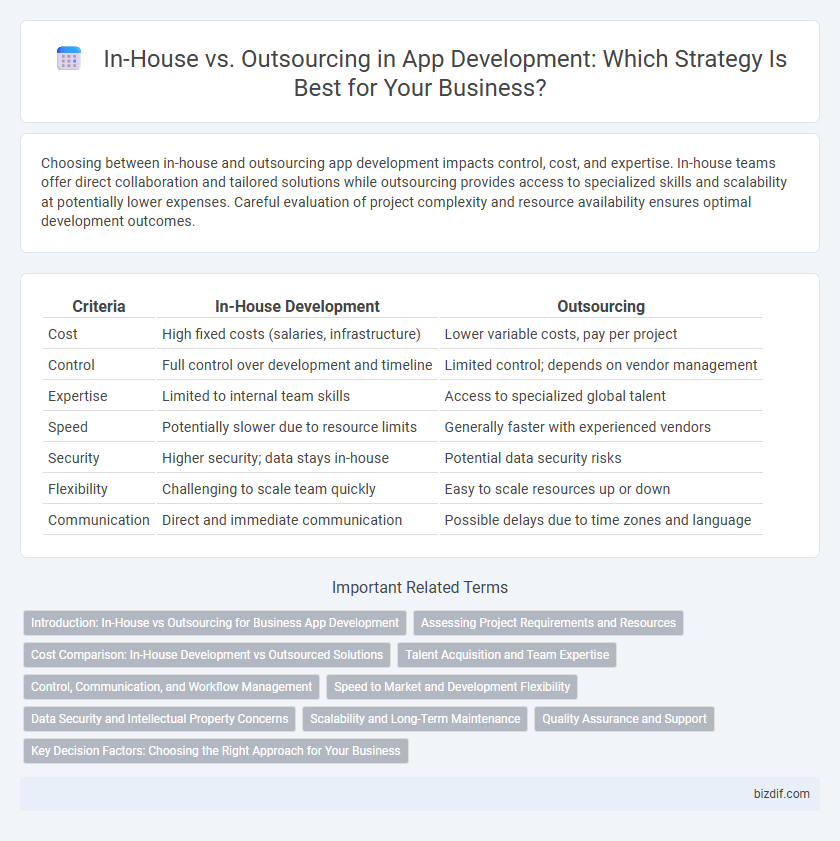Choosing between in-house and outsourcing app development impacts control, cost, and expertise. In-house teams offer direct collaboration and tailored solutions while outsourcing provides access to specialized skills and scalability at potentially lower expenses. Careful evaluation of project complexity and resource availability ensures optimal development outcomes.
Table of Comparison
| Criteria | In-House Development | Outsourcing |
|---|---|---|
| Cost | High fixed costs (salaries, infrastructure) | Lower variable costs, pay per project |
| Control | Full control over development and timeline | Limited control; depends on vendor management |
| Expertise | Limited to internal team skills | Access to specialized global talent |
| Speed | Potentially slower due to resource limits | Generally faster with experienced vendors |
| Security | Higher security; data stays in-house | Potential data security risks |
| Flexibility | Challenging to scale team quickly | Easy to scale resources up or down |
| Communication | Direct and immediate communication | Possible delays due to time zones and language |
Introduction: In-House vs Outsourcing for Business App Development
In-house app development provides businesses with direct control over the project, ensuring closely aligned goals and immediate communication with the development team. Outsourcing app development offers access to external expertise, cost efficiency, and scalability, often accelerating time-to-market for complex projects. Selecting between in-house and outsourcing depends on factors like budget, required skill sets, project timelines, and long-term maintenance needs.
Assessing Project Requirements and Resources
Assessing project requirements and resources is critical when choosing between in-house development and outsourcing for app development. In-house teams provide greater control over project scope and allow for easier collaboration with stakeholders, while outsourcing offers access to specialized skills and scalable resources for complex or time-sensitive projects. Evaluating factors such as budget constraints, technical expertise, project timeline, and internal capacity helps determine the most effective approach to meet business objectives efficiently.
Cost Comparison: In-House Development vs Outsourced Solutions
In-house development typically involves higher upfront costs due to salaries, benefits, and infrastructure investments, whereas outsourcing offers flexible pricing models that can reduce operational expenses. Companies often face hidden costs in outsourced solutions such as project management and communication overhead, which may impact the total cost of ownership. Analyzing cost per feature and time-to-market metrics provides a clearer comparison, revealing that outsourcing can be more cost-effective for short-term projects, while in-house development may yield better long-term value.
Talent Acquisition and Team Expertise
In-house app development teams offer direct control over talent acquisition, enabling companies to build specialized expertise aligned with their core business goals. Outsourcing provides access to a global pool of skilled developers, often accelerating project timelines with diverse technical proficiencies and scalable resources. Balancing in-house expertise with outsourced talent optimizes innovation, quality assurance, and cost efficiency in app development projects.
Control, Communication, and Workflow Management
In-house app development offers direct control over project direction, facilitating immediate decision-making and seamless alignment with company goals. Communication is streamlined through face-to-face interactions, enhancing clarity and reducing the risk of misunderstandings. Workflow management benefits from integrated teams using unified tools, ensuring real-time updates and adaptability throughout development stages.
Speed to Market and Development Flexibility
In-house app development offers greater development flexibility, allowing teams to quickly adapt to changes and iterate based on real-time feedback. Outsourcing accelerates speed to market by leveraging specialized expertise and established workflows that reduce ramp-up time. Balancing in-house and outsourced resources can optimize both rapid deployment and agile development processes.
Data Security and Intellectual Property Concerns
In-house app development offers enhanced control over data security protocols and safeguards intellectual property by keeping sensitive information within the organization. Outsourcing introduces risks such as potential data breaches and unauthorized access to proprietary code, making robust contractual agreements and rigorous vendor vetting essential. Companies must weigh these factors carefully to protect trade secrets and ensure compliance with industry-specific data protection regulations.
Scalability and Long-Term Maintenance
In-house app development offers greater control over scalability and long-term maintenance by allowing direct access to the development team for iterative improvements and quick adaptations as user demands grow. Outsourcing can provide scalable resources rapidly, but may introduce challenges in maintaining code consistency and communication over an extended project lifecycle. Choosing between in-house and outsourcing depends on the company's capacity to manage ongoing updates and the complexity of anticipated app scaling needs.
Quality Assurance and Support
In-house app development teams typically offer more direct control over Quality Assurance (QA) processes, ensuring seamless integration and quicker issue resolution tailored to specific project needs. Outsourcing QA and support can reduce costs and provide access to specialized expertise, but may introduce communication delays and less alignment with the development cycle. Effective collaboration tools and clear performance metrics are essential for maintaining high-quality standards and responsive support in both models.
Key Decision Factors: Choosing the Right Approach for Your Business
In-house app development offers greater control over project management, seamless communication, and direct alignment with company culture, which is crucial for businesses prioritizing proprietary technology and intellectual property security. Outsourcing provides cost efficiency, access to specialized expertise, and scalability, making it advantageous for companies seeking to reduce overhead and accelerate time-to-market. Key decision factors include budget constraints, project complexity, required expertise, timeline flexibility, and long-term maintenance considerations.
In-house vs Outsourcing Infographic

 bizdif.com
bizdif.com